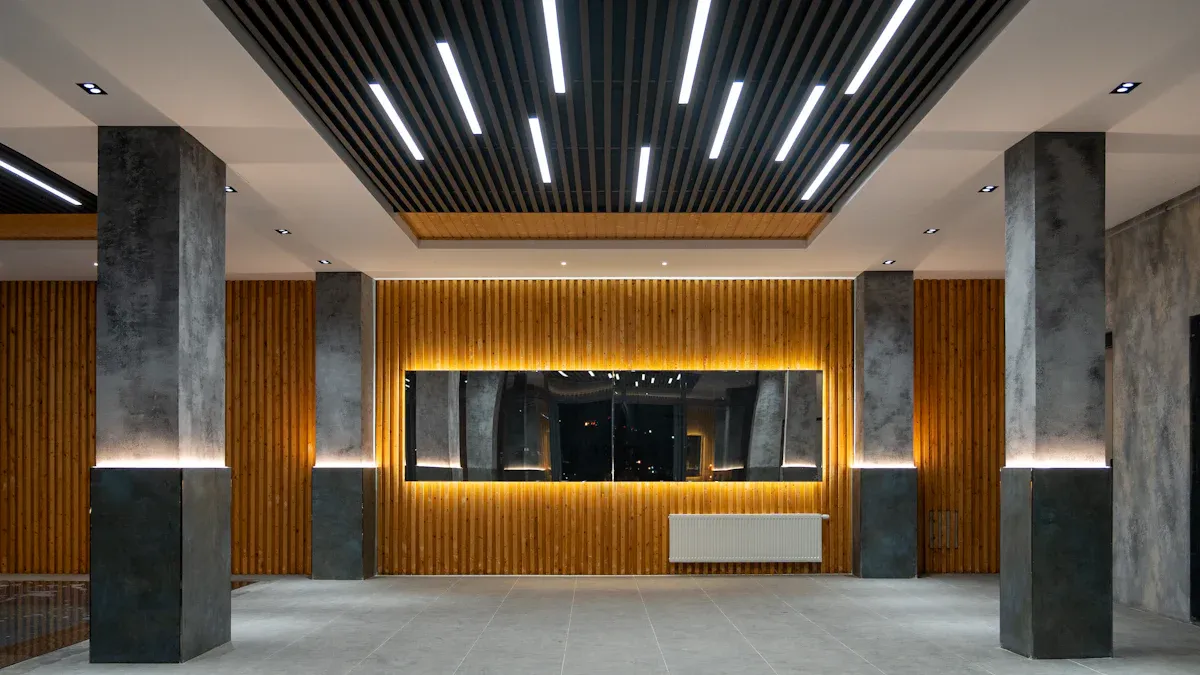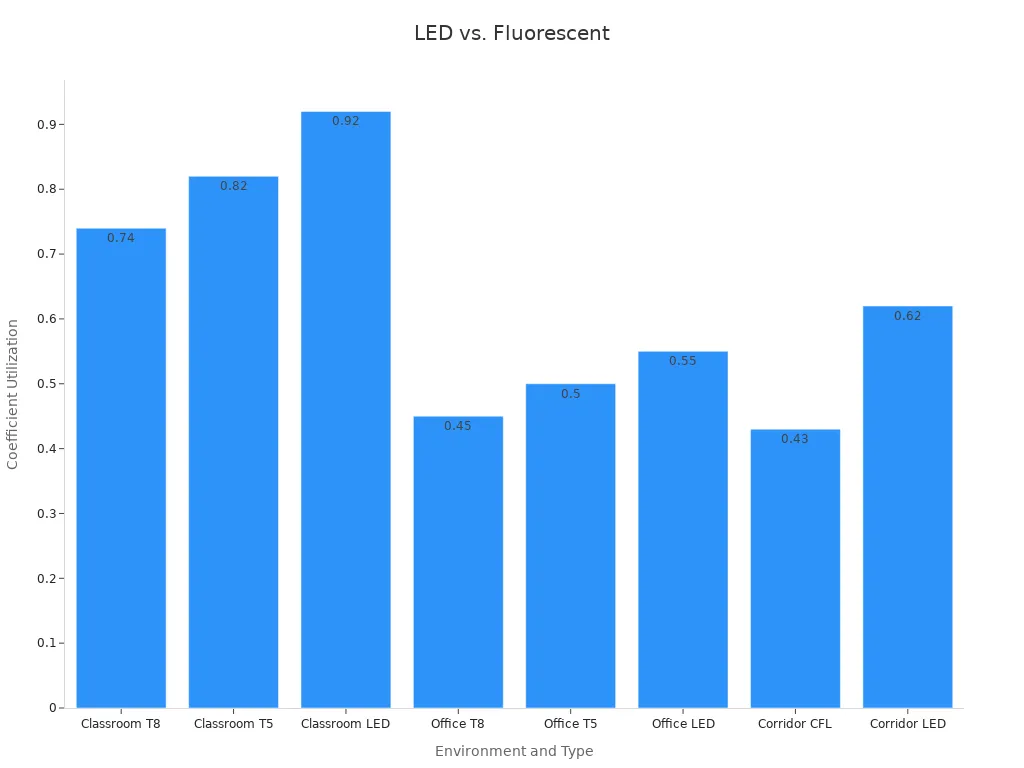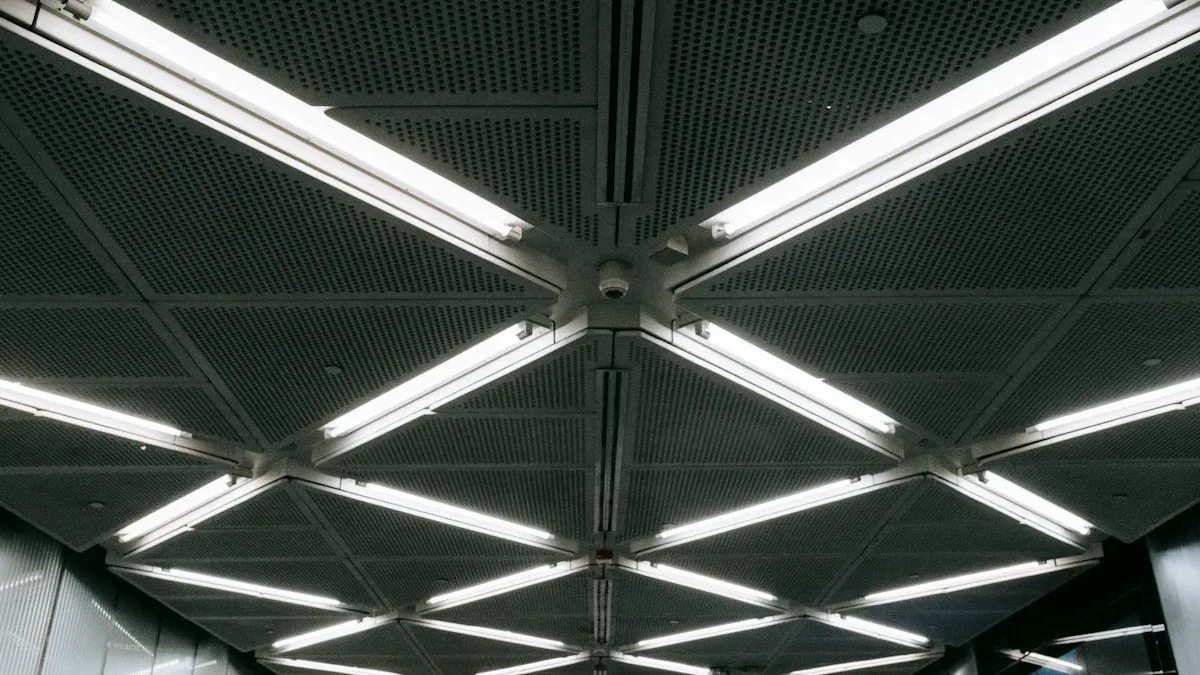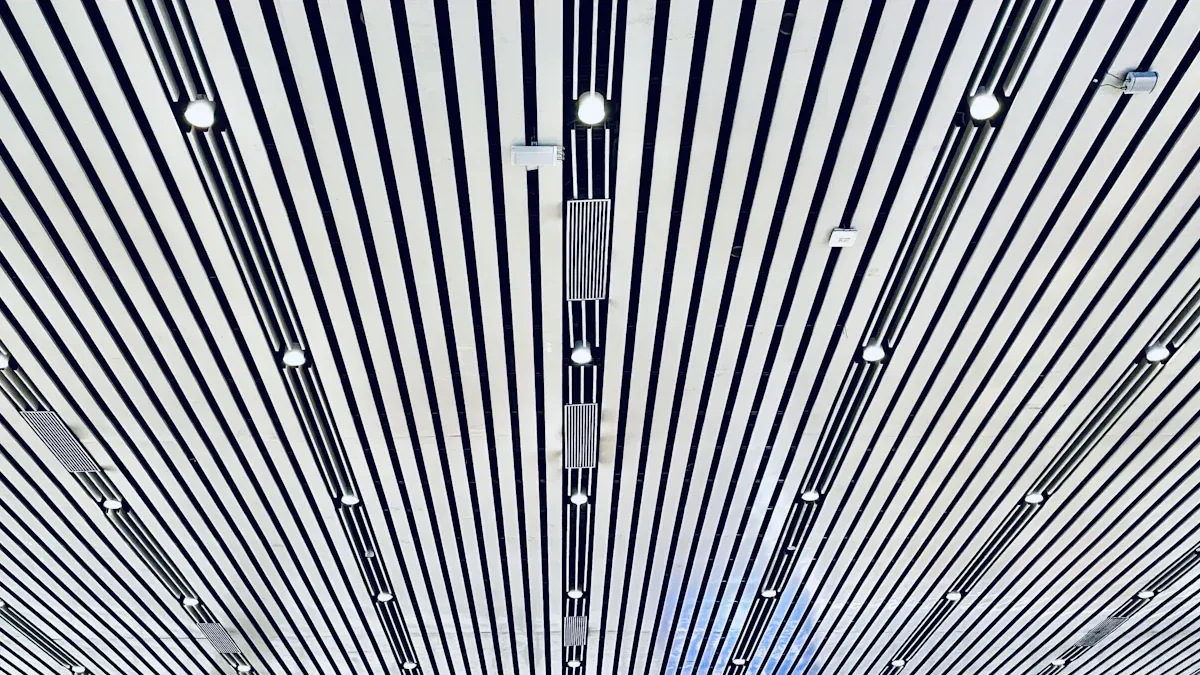LED Linear Products and how their linear lighting solutions compare in professional applications

LED linear products stand out in professional applications, offering unmatched energy efficiency, durability, and uniform illumination. Linear lighting solutions can reduce energy consumption by up to 90% compared to traditional lighting, driving down operational costs for offices and industrial environments. LED systems show superior durability, with maintenance cycles reaching 40,000 hours and consistent linear illumination across spaces. The chart below demonstrates how LED linear lighting achieves higher utilization and more even light distribution than traditional options.

Choosing the right lighting solution impacts productivity, safety, and long-term savings in all professional environments. About Us and Home pages often highlight how advanced Led Light Prouduct solutions outperform outdated systems in real-world applications.
Key Takeaways
LED linear lighting saves up to 80% energy compared to traditional bulbs, cutting costs and supporting sustainability.
These lights last over 40,000 hours, reducing maintenance and replacement needs for long-term value.
Linear fixtures provide even, glare-free illumination that improves comfort, safety, and productivity in workplaces.
Modular designs and plug-and-play features make LED linear lighting easy to install and customize for any space.
Businesses benefit from quick payback periods, government rebates, and extended warranties with LED linear products.
LED Linear Products Overview

What Are LED Linear Products
LED linear products use advanced technology to deliver efficient and reliable lighting in professional environments. These products include a range of linear fixtures, such as suspended, recessed, and surface-mounted options. LED linear lighting systems use rows of high-quality LED lights arranged in a straight line, providing even illumination across large spaces. Manufacturers design these fixtures for versatility, allowing them to fit into offices, warehouses, retail stores, and industrial settings.
Linear lighting fixtures stand out because they offer flexibility in design and installation. Users can connect multiple fixtures to create continuous lines of light or use them as standalone units. LED linear light fixtures often integrate with smart controls, enabling users to adjust brightness and color temperature for different tasks. The market for linear lighting continues to grow as more businesses seek sustainable and energy-efficient solutions.
Note: The U.S. Department of Energy reports that LED adoption in commercial and residential sectors increased from 8% in 2015 to 48% in 2020. This rapid growth highlights the performance advantages and widespread acceptance of LED linear lighting.
Key Benefits in Professional Use
LED linear lighting provides several key benefits for professional applications:
Energy efficiency: LED linear products consume less power than traditional fixtures, reducing utility costs.
Long lifespan: Many linear fixtures last over 40,000 hours, minimizing replacement needs.
Uniform illumination: Linear lighting delivers consistent brightness, improving visibility and comfort.
Flexible installation: Users can customize linear fixtures to fit unique layouts and design requirements.
Low maintenance: LED linear lighting requires fewer repairs, saving time and money.
The Linear Lighting Market is expected to grow significantly, driven by demand for energy savings and integration with smart technologies. Over 70% of customers purchase LED linear products through established distributors, reflecting strong supply chains and operational reliability. Studies show that LED linear lighting achieves a realization rate of 102% for energy savings, meeting or exceeding expectations in professional settings. These advantages make LED linear lighting the preferred choice for businesses seeking quality, efficiency, and long-term value.
LED Linear Lighting Performance
Energy Efficiency and Cost Savings
LED linear lighting delivers outstanding energy efficiency and cost savings in professional environments. These fixtures use advanced technology to produce more light with less power. For example, a 19-watt LED tube can replace a 36-watt fluorescent tube, cutting energy use by nearly half. Many linear fixtures use only 4 to 22 watts to match the brightness of a 60-watt incandescent bulb. This reduction in wattage leads to significant energy savings over time.
Lighting Type | Wattage Range (60W Equivalent) | Lifespan (hours) | Energy Efficiency / Cost Impact |
|---|---|---|---|
LED | 4-22 W | Up to 50,000 | Uses up to 90% less energy; long lifespan reduces replacement costs |
CFL | 9-52 W | 8,000-10,000 | Less efficient than LEDs; contains mercury |
Incandescent | 40-150 W | 1,000-2,000 | Least efficient; highest energy consumption |
LED linear lighting also helps reduce indirect costs. These fixtures emit less heat than traditional options, which lowers cooling expenses in offices and industrial spaces. Maintenance costs drop as well, since LED fixtures last much longer and require fewer replacements. Many businesses see energy savings between 50% and 80% after switching to LED linear lighting. The table below highlights these performance metrics:
Metric | LED Linear Lighting Performance | Traditional Lighting Performance | Benefit / Savings Description |
|---|---|---|---|
Energy Consumption Reduction | 50% to 80% less energy used | Baseline (e.g., metal halide) | Major reduction in energy use, leading to cost savings |
Wattage per Fixture | 150 W (LED High Bay) | 400 W (metal halide) | Saves up to 250 watts per fixture |
Maintenance Costs | Minimal | Higher | Reduced labor and material costs over time |
Indirect Energy Savings | Lower cooling load | Higher heat emission | Additional savings on HVAC systems |
Tip: LED linear lighting provides instant illumination, resists power surges, and performs well in cold temperatures. These features add to the overall cost-effectiveness and reliability of the fixtures.
Durability and Lifespan
LED linear lighting stands out for its exceptional durability and long lifespan. Most linear fixtures last between 40,000 and 100,000 hours, far outpacing incandescent and CFL bulbs. This extended lifespan means fewer replacements and less downtime for maintenance. Industry-standard tests, such as IES LM-80 and TM-21, confirm the reliability and longevity of LED fixtures.
LEDs often last 40,000 to 100,000 hours, while incandescent bulbs last only 750 to 2,000 hours and CFLs last 8,000 to 20,000 hours.
Manufacturers use standardized testing to verify the lifespan and lumen maintenance of each linear fixture.
Advanced heat sinks and cooling systems prevent overheating, which protects the quality and performance of the LEDs.
High-purity semiconductor materials and modern chip designs reduce defects and thermal stress, making each fixture more durable.
Quality constant current drivers with surge protection ensure stable power delivery and prevent early failures.
Many linear fixtures feature weatherproof and corrosion-resistant enclosures, allowing them to perform well in harsh environments.
LED linear lighting handles frequent on-off cycles better than traditional lighting, which helps maintain its long lifespan.
These features make LED linear lighting a smart investment for any professional setting. The combination of energy savings, reduced maintenance, and reliable performance ensures that businesses receive long-term value from their lighting systems.
Lighting Solution Features
Uniformity and Aesthetics
LED linear lighting delivers exceptional uniformity and visual appeal in professional environments. Designers value this lighting solution for its ability to create consistent illumination across large spaces. Uniform glare levels, with UGR values below 16 or 19, help reduce eye strain and improve comfort for employees. High color consistency, measured by SDCM less than 3, ensures that every area maintains the same color appearance. This level of uniformity supports a professional appearance in offices and commercial spaces.
Uniform light distribution minimizes shadows and glare, providing comfortable and reliable illumination.
Luminous efficacy above 130 lumens per watt supports bright and efficient lighting.
Sleek, minimalist designs enhance the overall lighting solution and contribute to a modern, professional appearance.
Versatile installation options, such as suspended, surface-mounted, and recessed, allow seamless integration with different layouts.
Customizable parameters, including length, beam angle, color temperature, and CRI, enable tailored lighting design for any project.
Advanced diffuser technologies, like microprismatic texturing, improve even light distribution and reduce glare.
Mechanical and thermal management features maintain color stability and consistent illumination over time.
Premium diffusers with high light transmission eliminate LED hotspots, while specialized diffusion patterns and reflective surfaces control beam angle and light spread. Durable materials, such as high-impact polycarbonate, ensure the lighting solution maintains its performance and appearance for years. These features make LED linear lighting design a top choice for professionals seeking both function and style in their illumination solutions.
Modularity and Customization
LED linear lighting stands out for its modularity and customization options. Modern lighting solution designs, such as the Sparkle LED luminaire, demonstrate how modular construction benefits professional applications. Additive manufacturing, including 3D printing, allows for fewer parts, toolless assembly, and easy disassembly. This approach supports circular design and material uniformity, making the lighting solution more sustainable.
Integrated heat sinks and housings create a single, efficient linear component.
Modular systems reduce the number of luminaires needed, cutting power density by up to 60%.
Customizable linear profiles allow designers to adjust length, beam angle, and color temperature for specific illumination needs.
Additive manufacturing eliminates fasteners and adhesives, streamlining production and enabling scalable, complex designs.
Innovative mechanical and thermal solutions support modular customization, ensuring reliable illumination in any setting.
These advancements in linear lighting design improve ceiling uniformity and application efficiency. By focusing on the strengths of LED technology, professionals can create lighting solutions that adapt to any environment. Modularity and customization ensure that every lighting solution meets the unique needs of each project, delivering optimal illumination and long-term value.
LED Solutions for Professional Applications

Offices and Commercial Spaces
LED linear lighting solutions have transformed commercial environments. Offices, government buildings, educational institutions, and healthcare facilities now rely on linear fixtures for their sleek design and continuous illumination. Many commercial applications use linear LED fixtures in corridors, meeting rooms, and workstations. These fixtures provide uniform lighting, which helps reduce eye strain and supports productivity.
Corporate offices lead the demand for LED solutions. They use linear lighting to lower energy costs and create modern, minimalist spaces.
Government buildings choose LED lighting for sustainability and long-term savings.
Educational institutions install linear fixtures to improve learning environments and manage operational budgets.
Healthcare facilities benefit from LED lighting’s color rendering, long lifespan, and low heat emission.
The global commercial LED office lighting market reached about USD 9.3 billion in 2023. Experts expect it to grow to USD 19.6 billion by 2032. This growth comes from energy efficiency, smart lighting technology, and the need for both functional and aesthetic improvements. Linear lights, panel lights, and downlights now dominate commercial applications, with linear fixtures gaining popularity for open-plan offices and clean lines. Facade lighting also plays a key role in commercial building design, providing both safety and visual appeal.
Industrial and Specialized Environments
Industrial applications require lighting solutions that withstand harsh conditions and deliver reliable illumination. LED linear fixtures excel in warehouses, manufacturing plants, and specialized environments. Case studies show that upgrading to LED lighting improves safety and energy efficiency. For example, a warehouse replaced outdated outlets and installed motion-sensor LED fixtures. This change reduced electrical hazards and provided automatic illumination only when needed, saving energy and boosting employee confidence.
Research highlights the shift from fluorescent tubes to LED alternatives in industrial settings. LEDs use less power, last longer, and generate less heat. They also avoid hazardous materials, making them safer for industrial and healthcare applications. Linear LED solutions adapt to many specialized needs, including refrigerated cases, parking garages, walkways, and task lighting for precision work. Facade lighting and outdoor application areas benefit from the durability and flexibility of linear LED fixtures. These solutions support both general and task lighting, ensuring consistent illumination for every industrial application.
Tip: LED linear lighting adapts to any commercial or industrial environment, from office task lighting to large-scale facade lighting. Facilities managers can choose modular fixtures to meet unique application needs.
Installation and Maintenance
Ease of Installation
LED linear lighting systems offer a straightforward installation process for most professional environments. Manufacturers design these fixtures for quick mounting, whether suspended, recessed, or surface-mounted. Many linear lighting products feature plug-and-play connectors, which reduce wiring time and lower the risk of installation errors. Contractors can often complete a led linear light installation with minimal disruption to daily operations.
The modular design of linear fixtures allows installers to connect multiple units in a continuous row or use them as standalone lights. This flexibility supports a wide range of layouts, from open offices to industrial warehouses. Unlike traditional fluorescent or metal halide systems, LED linear lighting does not require bulky ballasts or frequent tube replacements. Installers can also integrate smart controls and sensors during the initial setup, making the lighting system more efficient and adaptable.
Tip: Modular linear lighting systems help reduce installation time and labor costs, especially in large-scale projects.
Maintenance and ROI
LED linear lighting stands out for its low maintenance needs and strong return on investment. The long lifespan of LED linear fixtures means fewer replacements and less downtime. Facilities teams spend less time on relamping and repairs, which lowers labor costs over the years.
The table below compares maintenance and cost-effectiveness between LED linear lighting and traditional options:
Metric | LED Linear vs Fluorescent Example | LED High-Bay vs Metal Halide Example |
|---|---|---|
Lifespan (hours) | 50,000 vs 20,000 | 50,000 vs 10,000 |
Watts per fixture | 53W vs 128W | 160W vs 458W |
Upfront fixture cost | $249 vs $62 | $480 vs $0 (existing) |
Annual energy savings | $9,450 | $8,484 |
Labor hours for relamping | 4 workers × 25 hours | 2 workers × 8 hours |
Maintenance & energy savings over 10 years | $50,400 | $69,500 |
Payback period (energy only) | 5.62 years (18% ROI) | Under 3 years (35% ROI) |
Payback period (energy + maintenance) | 5.13 years (19.5% ROI) | Under 2.7 years (37% ROI) |
Payback period with rebates | Under 4 years (25.1% ROI) | 2.4 years (41.1% ROI) |
LED linear lighting provides longer service life and higher energy savings than fluorescent or metal halide systems. Facilities that switch to LED linear products see shorter payback periods, especially when local rebates apply. Over a decade, the savings from reduced maintenance and lower energy use add up, making LED linear lighting a cost-effective choice for any professional setting.
Comparing LED Linear Products to Alternatives
Performance Comparison
LED linear lighting stands out in professional applications due to its superior efficiency and longevity. Most LED linear products last between 25,000 and over 50,000 hours. This far exceeds the lifespan of incandescent bulbs, which typically last around 1,000 hours, and compact fluorescent lamps, which reach only 8,000 to 10,000 hours. Effective thermal management, such as integrated heat sinks and high-quality materials, helps maintain LED performance and extends the lifespan of each linear fixture.
LED linear lighting consumes much less energy than traditional bulbs. This efficiency leads to lower operational costs in offices, industrial spaces, and specialized applications like facade lighting. LEDs also operate at cooler temperatures, which further enhances their performance and makes them suitable for a wide range of environments, including refrigerated cases and outdoor walkways.
LED linear products do not fail suddenly. Instead, they gradually dim over time, reducing the need for emergency replacements and minimizing maintenance interruptions.
Proper installation and regular maintenance, such as ensuring adequate ventilation and avoiding extreme heat, support the durability of LED linear lighting. These features make LED linear solutions the best choice for applications that demand reliability, such as parking garages, task lighting, and facade lighting in commercial buildings.
A direct comparison highlights the advantages of LED linear lighting:
Feature | LED Linear Lighting | Incandescent/CFL/Metal Halide |
|---|---|---|
Lifespan (hours) | 25,000–50,000+ | 1,000–10,000 |
Energy Consumption | Up to 80% less | Baseline |
Heat Output | Low | High |
Failure Mode | Gradual dimming | Sudden |
Maintenance Frequency | Minimal | Frequent |
Suitability for Facade Lighting | Excellent | Limited |
LED linear lighting also delivers high luminous efficiency, often matching or surpassing fluorescent lamps. This makes it ideal for applications that require uniform and bright illumination, such as offices, industrial facilities, and facade lighting projects. Despite higher upfront costs, the long-term benefits of LED linear lighting make it the preferred solution for professionals seeking the best LED linear lighting for demanding environments.
Value and Warranty
LED linear lighting provides exceptional value in professional applications. The rapid return on investment comes from significant energy savings and reduced maintenance needs. Most LED linear products consume up to 80% less energy than traditional lighting, which results in substantial cost reductions for large-scale applications like office complexes, industrial plants, and facade lighting installations.
The long lifespan of LED linear lighting, often ranging from 50,000 to 100,000 hours, means fewer replacements and less downtime. This durability eliminates frequent replacement costs and supports continuous operation in critical applications, such as parking garages and walkway lighting. Minimal heat production from LED linear fixtures also lowers cooling expenses, further improving energy efficiency in commercial and industrial environments.
Many manufacturers offer extended warranties for LED linear lighting, reflecting the reliability and low failure rates of these products.
High-quality, glare-free illumination from LED linear lighting improves productivity and safety in workplaces. Government incentives and rebates often apply to LED upgrades, enhancing the financial benefits for businesses. These combined factors justify the extended warranty offerings and demonstrate the higher value of LED linear lighting compared to traditional options.
LED linear lighting offers:
Rapid ROI through energy and maintenance savings
Long lifespan with reduced replacement frequency
Lower cooling costs due to minimal heat output
Enhanced safety and productivity with glare-free light
Eligibility for government rebates and incentives
Extended warranty coverage due to proven reliability
LED linear lighting consistently outperforms alternatives in value, durability, and warranty support. Professionals in facade lighting, office, and industrial applications recognize LED linear products as the best LED linear lighting solution for long-term performance and cost-effectiveness.
LED linear products deliver unmatched performance in professional settings. Linear fixtures provide consistent illumination, long lifespan, and easy installation. Businesses see up to 80% lower energy use with LED linear lighting compared to incandescent bulbs. Linear solutions also last longer than CFLs. The U.S. Department of Energy projects that widespread LED linear adoption could save 348 terawatt-hours of electricity in the next decade. Linear LED lighting reduces costs and supports sustainability. Facility managers should consider upgrading to advanced linear LED systems for reliable, efficient, and future-ready lighting.
FAQ
What makes LED linear lighting suitable for professional spaces?
LED linear lighting provides even illumination and supports modern design. These fixtures fit many layouts and offer energy savings. Offices, warehouses, and retail stores benefit from their flexibility and long lifespan.
How does linear lighting improve workplace safety?
Linear lighting reduces shadows and glare. Workers see hazards more clearly. Consistent light levels help prevent accidents in industrial and commercial environments.
Can linear fixtures be customized for different projects?
Manufacturers offer linear fixtures in various lengths, colors, and mounting styles. Designers select options that match project needs. Customization ensures the lighting fits each unique space.
How often do linear LED lights need maintenance?
Most linear LED lights last over 40,000 hours. Maintenance needs remain low. Facilities teams spend less time on replacements and repairs.
Are linear lighting systems easy to install?
Installers find linear lighting systems straightforward. Modular designs and plug-and-play connectors speed up installation. Projects finish faster with less disruption.
See Also
Advantages And Uses Of LED Lighting In Industry
Comparing UFO Linear And Round LED High Bay Lamps
Best Practices And Benefits For LED Area Lighting

